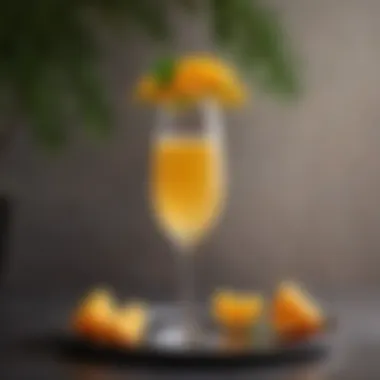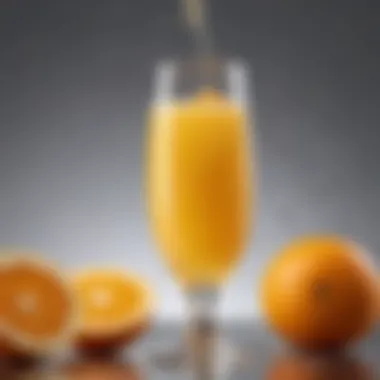Exploring the Fusion of Champagne and Orange Juice


Intro
The combination of champagne and orange juice is transformative, resulting in a drink that holds cultural significance in various settings. This blend is popularly known as the mimosa. Originating in France, it has gathered a diverse following around the world. Its rise in popularity reflects how culinary practices often evolve, bridging flavors and traditions across cultures.
The attractiveness of the mimosa lies not only in its refreshing taste but also in the social contexts it embodies. Typically consumed during brunch, it symbolizes celebration and leisure. Understanding how this drink came to prominence offers insight into how food and drink can create shared experiences. This exploration will dive into the historical, preparation, and cultural significance related to the mimosa, highlighting its importance to food enthusiasts.
Recipe Overview
Dish Description
The mimosa typically consists of a simple yet elegant mix of freshly squeezed orange juice and chilled champagne. The balance between the citrus sweetness of the orange juice and the crispness of the champagne creates a light, sparkling sensation that captivates the palate.
Cuisine Type
This beverage aligns well with light fare commonly associated with brunch. The ease of preparation makes it adaptable to various events. From intimate gatherings to large celebrations, the mimosa fits seamlessly into the cuisine of celebratory occasions.
Ingredients List
Detailed Ingredients
- Freshly squeezed orange juice: Quality matters; use ripe oranges for ideal sweetness and flavor.
- Champagne: A good quality champagne is essential. Options like Moët & Chandon or Veuve Clicquot are popular choices.
Substitutions and Variations
- Juice Variations: Besides orange juice, consider alternatives such as grapefruit or pomegranate juice for different flavor profiles.
- Wine Alternatives: Prosecco or Cava can also be used instead of champagne for more approachable options.
- Flavor Additions: Infuse with herbs like mint or basil for a twist on the classic taste.
"The mimosa, while simple, captures the essence of brunch culture. It is a drink of joy, often considered liquid sunshine."
This foundation on the mimosa sets the stage for further exploration into its history, preparation methods, and variations. Engaging with this beverage not only treats the palate but also provides a window into the culinary landscapes that shape our dining experiences.
Prelude
The fusion of champagne and orange juice holds both a culinary and cultural significance in the realm of beverages. This combination is widely recognized as a mimosa, and it epitomizes a specific lifestyle marked by celebration and indulgence. Exploring this blend not only highlights the nuances of flavor but also traces the origins and evolution of this popular drink within social contexts.
The importance of this topic lies in understanding how two simple ingredients come together to create a widely cherished beverage. The balance between the effervescent brightness of champagne and the sweet, tangy notes of orange juice enhances the drinking experience significantly. Recognizing the various qualities—such as the choice of orange juice and the type of champagne—can elevate the overall quality of the mimosa.
This introductory section will set the stage for a deeper examination of historical influences, preparation methods, and modern adaptations. By investigating the intricate details of the mimosa, we can appreciate its place in contemporary social rituals, making it more than just a drink. It serves as a symbol of celebration, bringing people together in shared moments of joy.
The journey through the world of mimosas also invites food enthusiasts to analyze and experiment with their own variations and presentations. Engaging with this topic will provide valuable insights into ingredient selection, making it both informative and practical for readers. As we delve further into the article, expect a thorough exploration of the elements that maintain the integrity of this beloved beverage.
Historical Background
The historical background of the mimosa is essential to understanding its significance in culinary culture. This section delves into the origins of its primary components and how they collectively contributed to the creation of this beloved beverage. Appreciating the history behind champagne and orange juice adds depth to the enjoyment of the mimosa, which is often best savored during special occasions or leisurely brunches.
Origins of Champagne
Champagne, a sparkling wine from the Champagne region of France, has a history dating back to the Roman era. The unique climate and soil of the region favor the cultivation of specific grape varieties, particularly Pinot Noir, Pinot Meunier, and Chardonnay. In the 17th century, a well-known monk named Dom Pérignon was influential in the development of methods to produce sparkling wine. His innovations in fermentation and blending helped elevate the quality and prestige of champagne. The drink became synonymous with luxury and celebration. This background contributes to the mimosa's character, as it encapsulates the essence of festivity.
The Emergence of Orange Juice


Orange juice has its roots in Asia, where the orange fruit itself was first cultivated. Sliced and referred to as a healthful delicacy, it became part of diverse culinary traditions. The juice extract gained popularity in the 19th century. It was recognized for its nutritional benefits, especially its rich vitamin C content. This adds a layer of appreciation to the mimosa. Freshly squeezed orange juice acts as a complement to the effervescence of champagne, creating a harmonious blend.
The Birth of the Mimosa
While its exact origin is somewhat obscure, the mimosa is believed to have been created in the 1920s. The name "mimosa" is inspired by the acacia dealbata plant, known for its vibrant yellow flowers which resemble the drink's golden hue. The combination of champagne and orange juice began appearing in brunch menus and celebratory gatherings. It represented a creative approach to cocktail making, enhancing traditional drinking culture. The mimosa encapsulates a blend of the old and the new, where classic beverages meet modern creativity.
The evolution of the mimosa illustrates how food and drink transcend generations, reflecting social customs and preferences.
Overall, the historical background of the mimosa paints a rich portrait of its evolution. Understanding the origins of champagne and orange juice enriches the drinking experience, making it more than just a beverage; it is a symbol of celebration and culinary artistry.
Ingredients in Focus
When discussing the mimosa, it is crucial to delve into the ingredients that create this unique beverage. The pairing of champagne and orange juice forms the foundation, and understanding each component can enhance the overall experience. The quality of champagne, the selection of orange juice, and the potential flavor enhancers all play significant roles in determining the final taste and appeal of a mimosa. Acknowledging these elements fosters a greater appreciation of the drink and allows enthusiasts to make informed choices.
Quality of Champagne
The choice of champagne is vital to the execution of a successful mimosa. While some may believe that any sparkling wine will suffice, the depth of flavor and complexity found in high-quality champagnes cannot be overlooked. A premium label, such as Moët & Chandon or Veuve Clicquot, brings with it notes of apple, pear, and a hint of brioche, which can nicely complement the sweetness of orange juice.
Additionally, the bubbles in champagne contribute to the texture and mouthfeel of the cocktail, creating a delightful contrast with the smoothness of the juice. It is recommended to select a brut champagne, as its drier profile balances out the sweetness that orange juice naturally possesses. A conscious decision regarding quality ensures that each sip of the mimosa is a pleasing experience.
Choosing the Right Orange Juice
Selecting the appropriate orange juice serves as the second cornerstone of a great mimosa. Freshly squeezed juice is undeniably the best option. It captures the natural flavors and aromas of the oranges, providing the drinker with a burst of freshness. However, if convenience is a concern, many reputable brands offer high-quality, 100% pure orange juice. Brands like Tropicana and Simply Orange maintain superior quality and flavor without unnecessary additives.
When considering juice, it's essential to be mindful of sweetness. The oranges should be ripe and juicy, as they influence the drink's overall character. If using store-bought options, look for juices labeled with no added sugars. This ensures a more authentic taste experience, keeping true to the delicate balance the mimosa embodies.
Additional Flavor Enhancers
While the classic mimosa consists of only champagne and orange juice, it can also be enhanced with a variety of additional flavors. Here are a few options to consider:
- Fruit Purees: Adding a splash of mango or raspberry puree can elevate the mimosa beyond its traditional roots. These purees add a vibrant color and unique taste, creating a multi-dimensional drink.
- Liqueurs: Infusing drinks with liqueurs, such as Grand Marnier or Cointreau, can introduce a hint of orange flavor, deepening the drink’s profile. A small amount goes a long way in enhancing the overall experience.
- Herbs and Spices: Fresh mint or basil can add an unexpected twist, offering fresh aromatic notes. On the other hand, a dash of nutmeg or cinnamon can introduce warmth and depth to the flavor.
Utilizing these enhancers broadens the mimosa's appeal, allowing for experimentation and customization to cater to personal tastes.
Preparation Techniques
The preparation techniques of mixing champagne and orange juice, which culminate into the mimosa, are crucial to achieving a delightful and harmonious drink. These techniques not only ensure flavor balance but also influence the overall experience of enjoying this beverage. A well-prepared mimosa can elevate an occasion, whether it is a casual brunch or a celebratory gathering.
Mixing Ratios
Getting the mixing ratios correct is essential. The standard guideline suggests a 1:1 ratio of champagne to orange juice, but this can be adjusted according to personal taste.
- Classic Balance: A 50/50 ratio works well for most palates, offering a refreshing taste without overwhelming the champagne's sophisticated notes.
- Adjusting Intensity: Some prefer a stronger champagne flavor. In this case, a ratio such as 2:1 (two parts champagne to one part orange juice) can be more appealing.
- Using Premium Ingredients: If high-quality champagne like Moët & Chandon is used, one might lean toward more champagne to let its flavors shine through.
The flexibility in ratios allows for customization, making it a personal choice rather than a strict rule.
Serving Methods
Serving methods play a significant role in the enjoyment of the mimosa. The presentation should be appealing as well as functional.
- Glassware Choice: Traditional champagne flutes are often preferred. They help preserve carbonation and present the drink beautifully. Alternatively, a white wine glass can enhance the experience by allowing aromatic appreciation.
- Chilled Ingredients: Ensuring that both the champagne and orange juice are cold before mixing is crucial. This promotes a refreshing drink rather than one that warms quickly and loses its sparkle.
- Batch Preparation: For events, consider preparing a large pitcher of mimosa. This allows guests to easily serve themselves. Alternatively, individual servings can also be a delightful method, personalizing the experience for friends.


Garnishing and Presentation
The garnishing and presentation of a mimosa can elevate the visual appeal and overall experience.
- Citrus Slice: A thin slice of orange on the rim brings an eye-catching touch and hints at the flavors inside the glass.
- Fresh Herbs: Adding mint or basil as a garnish offers an unexpected freshness that can enhance the mimosa’s profile.
- Rim Sugar: Consider rimming the glass with orange-flavored sugar for a sweet twist.
A thoughtful presentation can stimulate the senses even before the first sip is taken.
"The art of preparing a mimosa is not merely in the ingredients but also in the experience it creates for those who gather to share it."
This segment illustrates how proper preparation techniques can significantly alter the experience of enjoying a mimosa, transforming a simple drink into a cherished moment.
Nutritional Analysis
Understanding the nutritional aspects of combining champagne and orange juice is essential in appreciating the mimosa. This section will focus on caloric considerations, health benefits associated with orange juice, and the importance of moderation when consuming alcohol. Nutrition plays a vital role in flavor balance and overall enjoyment of the mimosa. By analyzing these elements, we can gain insight into this drink's suitability for different occasions and health consciousness.
Caloric Considerations
Calories are a crucial factor to consider when examining the mimosa. A traditional mimosa usually consists of equal parts champagne and orange juice. The caloric content can vary significantly based on the types of champagne and juice used. On average, a standard serving of a mimosa contains around 70 to 100 calories. Here's a breakdown:
- Champagne: Typically, a standard serving of champagne provides approximately 80 calories per 5-ounce glass.
- Orange Juice: Fresh orange juice adds about 55 calories per 4-ounce serving.
This means that the total calorie count for a basic mimosa can hover around 135 calories. Individuals seeking to enjoy a mimosa while managing caloric intake can consider using sparkling water to lighten the drink or opting for a lower-calorie juice variant. This analysis can help cater to various dietary preferences.
Health Benefits of Orange Juice
Orange juice is not just a flavorful component of the mimosa; it also offers numerous health benefits. Here are some critical elements:
- Vitamin C: Rich in vitamin C, orange juice boosts the immune system. Vitamin C also acts as an antioxidant, helping the body to fight oxidative stress.
- Folate: Orange juice contains folate, which is essential for cell growth and metabolism, particularly important during pregnancy.
- Potassium: The potassium in orange juice can help manage blood pressure levels, promoting heart health.
- Hydration: With its high water content, orange juice aids in hydration, making it a refreshing addition to any beverage.
Despite these benefits, moderation is necessary, as excessive intake of fruit juice can lead to increased caloric consumption and sugar intake, impacting the health benefits negatively.
Alcohol Content and Moderation
Alcohol moderation is a vital aspect when enjoying mimosas. Champagne typically has an alcohol by volume (ABV) ranging from 10% to 12%. When mixed with orange juice, the overall ABV of the mimosa decreases, which may lead to underestimating the actual alcohol intake. Here are some important points to consider:
- Serving Size: A standard 5-ounce serving of mimosa will usually contain less alcohol than pure champagne, making it potentially easier to drink in larger quantities without realizing.
- Effects of Alcohol: Being aware of the effects of alcohol is essential for responsible drinking. It is advisable to pace oneself and not exceed recommended daily alcohol limits.
"Moderation is key when enjoying mimosas, especially during gatherings where the drink is popular."
Cultural Significance
The cultural significance of the mimosa extends beyond its refreshing taste. It embodies a blend of tradition, celebration, and social interaction. This beverage has become synonymous with particular events, notably brunch gatherings and festive occasions. The very act of sharing mimosas often fosters connections among people, making it a beverage that transcends generations and social boundaries.
Mimosas in Celebrations
Mimosas hold a special place in various celebrations. It’s not uncommon to see them at weddings, baby showers, or holiday brunches. Their vibrant color and bubbly texture add a festive charm. The act of toasting with mimosas often marks significant milestones. This beverage enhances the joy of gathering, acting as a catalyst for laughter and conversation. Additionally, the simplicity of the recipe means that it is accessible to many, allowing it to be included in varied celebrations regardless of the budget.
Regional Preferences
Regional differences affect how mimosas are enjoyed around the world. In areas with a strong brunch culture, such as the United States, they are a menu staple. However, in other regions, variations on the drink may feature local fruits aside from oranges. For instance, some might favor a grapefruit mimosa or even a mix of strawberries and prosecco. Understanding these preferences offers insights into local traditions and the influences of local cuisine. The adaptability of the mimosa speaks to its universal appeal while honoring regional tastes and styles.


Trends in Beverage Pairings
As culinary trends evolve, so do the pairings that accompany mimosas. Modern dining often emphasizes the importance of complementary flavors. Thus, mimosas are frequently served alongside diverse dishes, from savory egg dishes to sweet pastries. Furthermore, the rise of craft cocktails has introduced variations that incorporate local spirits or unique infusions. Pairing mimosas with artisanal cheeses or charcuterie boards has gained traction, providing a sophisticated experience. This trend highlights how mimosas can elevate the dining experience, pushing the boundaries of flavor combinations.
Mimosas are more than just drinks; they are symbols of joy and connection that bring people together during life’s special moments.
Modern Adaptations
Modern adaptations of the traditional mimosa reflect the evolving nature of culinary preferences and drinking habits. These adaptations are not merely variations in recipe; they often represent broader trends in health consciousness, innovation in flavor profiles, and the desire for unique drinking experiences. The flexibility in mixing champagne with various juices and flavors allows restaurants and home bartenders alike to experiment, fostering creativity in beverage preparation. This section will explore how the classic mimosa is being transformed while maintaining its essence as a beloved brunch staple.
Variations on the Traditional Recipe
While the classic mimosa comprises simply champagne and orange juice, contemporary twists can involve a multitude of ingredients. Here are some notable variations:
- Fruit Juices: Beyond orange juice, many mixologists use juices such as grapefruit, pomegranate, or blood orange. These alternatives offer distinct flavors and can enhance the drink's visual appeal.
- Sweeteners: Adding honey, agave nectar, or flavored syrups introduces sweetness that can balance acidity without relying solely on juice.
- Garnishes: Fresh herbs like mint or basil, or even edible flowers, can be used to elevate the aroma and presentation of the drink.
These variations not only cater to diverse tastes but also allow for personalization, which is increasingly appreciated by today’s food enthusiasts.
Use of Different Sparkling Wines
In the realm of modern mimosa preparation, the choice of sparkling wine extends beyond traditional champagne. Prosecco, Cava, and even local sparkling wines create a different character for the drink.
- Prosecco offers a sweeter, fruitier flavor that harmonizes well with various juices.
- Cava, known for its crispness, can provide a more refreshing profile, particularly suited for lighter fruit combinations.
- Local Sparkling Wines highlight regional craftsmanship and can add a unique touch, making them ideal for showcasing local flavors.
The exploration of different sparkling wines can transform the mimosa experience, opening up new avenues for flavor exploration and higher enjoyment.
Incorporating Infusions and Flavors
Recent trends in cocktail culture focus on infusion and flavor enhancement. Infusing champagne or sparkling wines with various fruits, herbs, or spices allows for deeper flavor engagement. Some popular ideas include:
- Herbal Infusions: Adding rosemary or thyme can impart a fragrant quality that adds complexity to the drink.
- Spice Infusions: Cinnamon sticks or star anise can introduce warm spice notes, perfect for seasonal adaptations.
- Fruit Infusions: Marinating strawberries, raspberries, or kiwi in the champagne before mixing not only boosts flavor but also creates a colorful presentation.
Experimenting with these elements not only enhances the drink's profile but also engages the drinker in a journey of flavor discovery, making each sip unique.
"Modern adaptations of the mimosa illustrate the endless possibilities that arise from culinary creativity, marrying tradition with innovation."
In summary, today's adaptations of the mimosa cater to evolving tastes and preferences while inviting creativity and experimentation. With a focus on diverse ingredients and methods, the classic beverage continues to thrive in modern dining and social settings.
Epilogue
In exploring the fusion of champagne and orange juice, this article reveals the rich tapestry of history, flavor, and cultural significance behind the mimosa. The combination of these two ingredients is not just a drink but a symbol of celebration and joy in various contexts. As we move towards a future where culinary boundaries continue to blur, understanding the subtleties of this beloved beverage becomes essential.
The Future of Mimosas
The future of mimosas looks both vibrant and innovative. As consumer preferences evolve, so do the interpretations of traditional recipes. One noticeable trend is the rise of alternative fruit juices, such as pomegranate or cranberry. These juices provide different flavor profiles that can complement the wine. Moreover, the shift towards health-conscious choices has led to a rise in low-calorie champagne options.
"With the rise of craft cocktails, mimosas may soon become a canvas for experimentation, mixing unexpected ingredients together."
Beyond juice and champagne, infused beverages are gaining traction. Herbal and botanical infusions can add complexity to the mimosa experience. Bartenders and home enthusiasts are encouraged to embrace this trend and think creatively about seasonal ingredients.
Final Thoughts on Pairings and Occasions
The significance of mimosas transcends mere taste. Pairing them with food requires consideration of flavor balance and occasion. When served at brunch, mimosas often accompany dishes like eggs Benedict or fresh fruit. The citrus notes from orange juice can elevate rich flavors present in these meals.
An important consideration is the context in which mimosas are enjoyed. Weddings, baby showers, and holiday gatherings all create memories that are enhanced by this refreshing drink. By exploring various pairings and occasions, one can appreciate the versatility of the mimosa.
In summary, the culinary journey of pairing champagne and orange juice illustrates a delightful blend of tradition and creativity. Understanding its nuances ensures that every sip is not just enjoyable but also meaningful.







